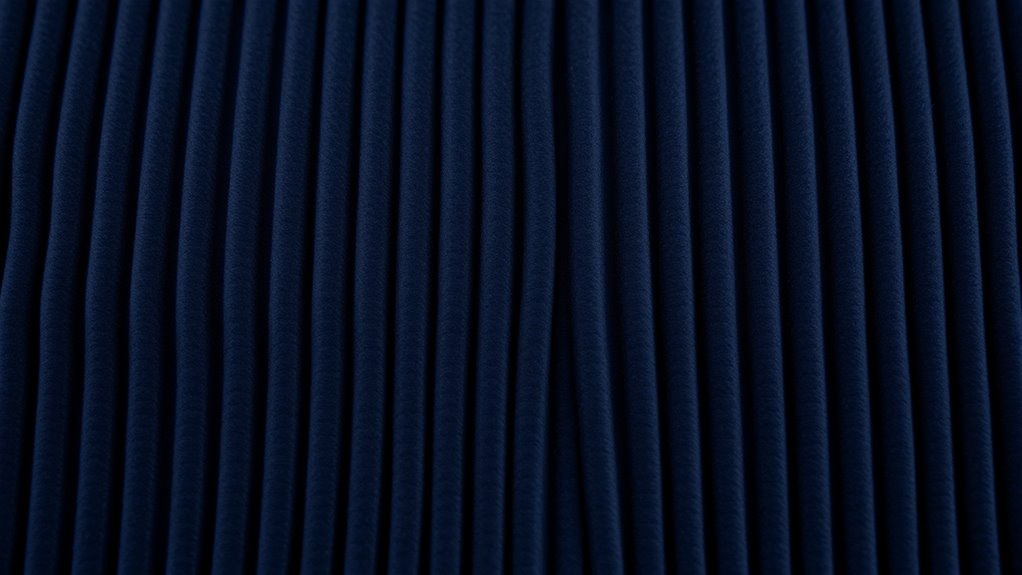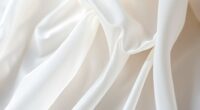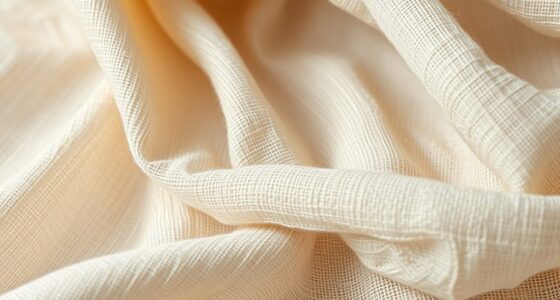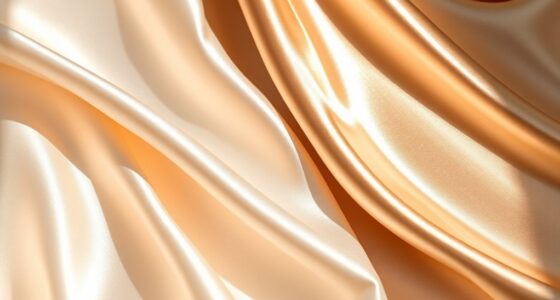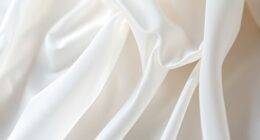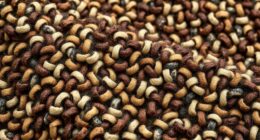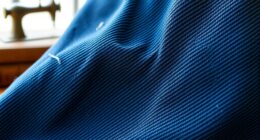Corduroy is a sturdy fabric featuring raised ridges called wales, formed by weaving extra yarns and cutting pile fibers to create a soft, ribbed texture. Its durable structure makes it ideal for jackets, trousers, skirts, and upholstery, offering both practicality and vintage charm. Different wale widths give unique looks, appealing to various fashion styles. If you’re curious about its history or how it’s made, there’s more to explore about this textured, timeless fabric.
Key Takeaways
- Corduroy is a textured fabric characterized by raised ridges called “wales” created through a specific weave pattern.
- Its structure involves weaving extra yarns and cutting pile yarns to form plush, durable ridges.
- Originating in 17th-century France or England, it was initially used for sturdy workwear and outdoor garments.
- Modern variations feature different wale widths, offering diverse aesthetic options for fashion and upholstery.
- Popular for jackets, trousers, skirts, and upholstery, due to its durability, textured appearance, and vintage charm.
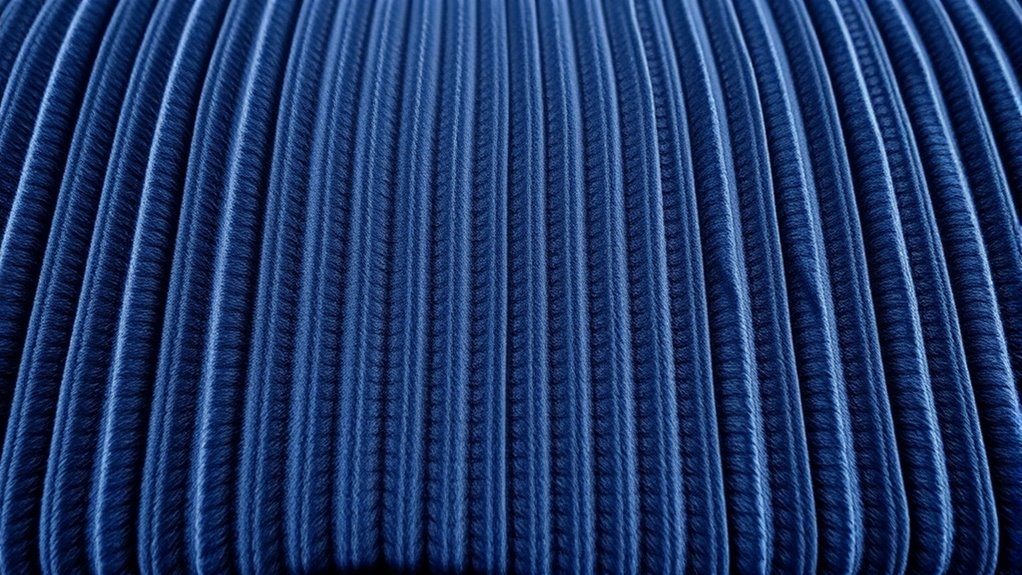
Corduroy is a distinctive fabric known for its raised ridges, called wales, which give it a textured, ribbed appearance. These wales are created through a specific weave pattern that sets corduroy apart from other textiles. The weave pattern involves weaving extra sets of yarns into the fabric, forming the characteristic ridges and the soft, velvety background. This process involves cutting the pile yarns to form the wales, resulting in a plush, durable surface. The weave pattern is carefully crafted to guarantee the ridges are uniform and resilient, making corduroy both stylish and practical. Its unique structure not only provides visual appeal but also enhances warmth and durability, making it a popular choice for various clothing and home furnishings.
Understanding the historical origins of corduroy enriches your appreciation of this fabric. Its roots trace back centuries, with origins possibly dating to 17th-century France or England. Some historians believe the fabric’s development was influenced by the need for sturdy, warm garments for laborers and outdoor workers. The name “corduroy” is thought to derive from the French phrase “corde du roi,” meaning “king’s cloth,” which hints at its early association with nobility. Over time, the fabric became more accessible and popular among the general population, especially during the Industrial Revolution when mass production made it more affordable. Its textured appearance and durability made it ideal for workwear, and later, fashion designers adopted it for stylish, casual clothing. The evolution of corduroy’s weave pattern over centuries reflects a blend of practicality and aesthetic appeal, with modern variations often featuring different wale widths to cater to various fashion tastes.
Today, the distinctive weave pattern and rich history make corduroy a versatile fabric used in many applications. Its textured surface lends a vintage charm to jackets, trousers, skirts, and upholstery. The fabric’s durability ensures it withstands regular wear, while its warmth makes it suitable for colder climates. Fashion brands appreciate its timeless appeal, often experimenting with wider or narrower wales to create different visual effects. The historical origins of corduroy remind you that this fabric has been valued for centuries, balancing function and style. Whether you’re dressing up in a corduroy blazer or adding a cozy touch with a pillow cover, understanding its weave pattern and history helps you appreciate why this fabric has remained popular for so long. Its resilience, unique texture, and rich past continue to endear corduroy to everyone who values both tradition and contemporary fashion.
Frequently Asked Questions
How Do I Care for and Clean Corduroy Garments?
To care for your corduroy garments, machine wash them inside out on a gentle cycle with cold water. Use mild detergent and avoid bleach. For stain removal, treat stains promptly with a soft cloth and mild stain remover, gently dabbing rather than rubbing. Allow your corduroy to air dry to prevent shrinking or damage. Regularly brushing the fabric can help maintain its texture and keep it looking fresh.
What Are the Different Types or Varieties of Corduroy?
Did you know there are over 20 different corduroy patterns? You can choose from varieties like wide-wale, narrow-wale, and pinwale, each offering unique textures. Fabric weight options range from lightweight for shirts to heavyweight for jackets, giving you versatility. These types let you customize your style and functionality, whether you’re aiming for a sleek look or cozy comfort. Mixing patterns and weights helps you find the perfect corduroy for any project.
Is Corduroy Suitable for All Seasons and Climates?
Yes, corduroy offers good seasonal versatility and climate suitability. You can wear it in cooler months, thanks to its insulating fabric, making it perfect for fall and winter. However, thinner varieties work well in spring and early summer, especially in moderate climates. Just choose the right weight and weave to match your local climate, ensuring comfort year-round. Corduroy adapts well, so you can enjoy its style across seasons.
How Does Corduroy Compare to Other Similar Fabrics Like Velvet?
Think of corduroy as a cozy, ridged friend, while velvet is like smooth, plush silk. You’ll find corduroy offers rugged fabric durability, perfect for everyday wear, with a textured comparison that’s more tactile and structured. Velvet, on the other hand, drapes softly and feels luxurious, but isn’t as tough. So, if you want durability and a distinctive pattern, corduroy’s your go-to; for elegance, velvet’s the better choice.
Can Corduroy Be Blended With Other Fibers for Different Textures?
Yes, you can blend corduroy with other fibers to create different textures. Fiber blending allows you to add softness, durability, or sheen, giving your fabric a unique feel and appearance. This technique offers excellent texture variation, making your garments or upholstery more interesting. By mixing fibers like polyester, wool, or silk with traditional cotton corduroy, you can customize the fabric to suit your style and functional needs.
Conclusion
Now that you know what makes corduroy unique, imagine the endless possibilities it holds. Its rich texture and durability could transform your wardrobe in unexpected ways. But there’s more to discover—what hidden styles or innovative uses could you create with this versatile fabric? Don’t stop here; explore further and unleash the full potential of corduroy. The next trend or timeless classic might just be waiting for you to bring it to life.
